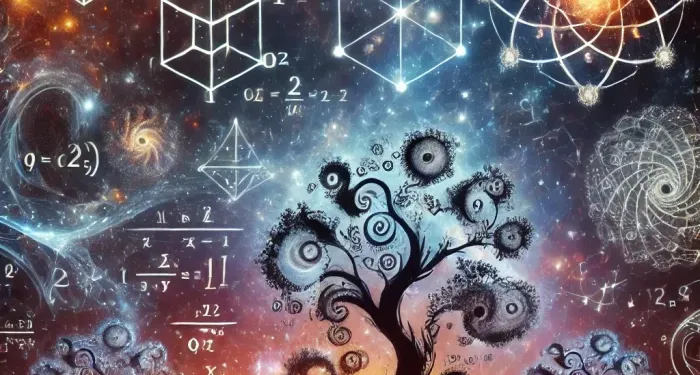Dr. Reyaz Ahmad
At its core, mathematics is about recognizing patterns and relationships. While the objects under study might seem unrelated at first glance, mathematical structures often reveal hidden connections. This act of naming is not merely linguistic—it is conceptual. It means that different phenomena, which behave similarly under certain rules, can be studied using the same mathematical models. This leads to a greater understanding and fosters a sense of universality in our knowledge.
For example, the same equation can describe:
The orbit of planets.
The trajectory of a rocket.
The motion of a pendulum.
This is because these systems share an underlying similarity in their dynamics, despite their superficial differences.
Examples of Unification in Mathematics
1. The Circle: A Universal Framework
The concept of the circle appears in diverse domains:
Geometry: A circle is defined as the set of all points equidistant from a given point (the center).
Trigonometry: The sine and cosine functions, foundational in describing oscillatory behavior, originate from the unit circle.
Physics: Circular motion and waves, such as sound or light waves, are inherently related to the geometry of circles.
What makes this remarkable is that a purely geometric idea finds application in physical phenomena like planetary orbits, harmonic motion, and signal processing.
2. Graph Theory: Connecting the Dots
Graph theory uses vertices (points) and edges (lines) to model relationships. Initially studied in pure mathematics, its applications span:
Biology: Modeling neural networks in the brain, where nodes represent neurons and edges represent synaptic connections.
Social Sciences: Analyzing social networks like Facebook or Twitter, where nodes represent individuals and edges represent relationships or interactions.
Technology: Representing the internet as a graph of servers (nodes) and their connections (edges).
Despite these diverse settings, the mathematics remains the same. Algorithms like Dijkstra’s (for shortest paths) or PageRank (used by Google) apply universally to all these graphs.
3. Symmetry and Group Theory
Group theory, a branch of abstract algebra, studies the concept of symmetry. It unifies:
Nature: Snowflakes, crystals, and molecular structures exhibit symmetry, explained by mathematical groups.
Physics: The fundamental forces of nature (like electromagnetism and gravity) are described using symmetry groups.
Art and Design: Patterns in Islamic tiling or Renaissance art are based on the mathematical principles of symmetry.
By giving a common name—groups—to these phenomena, mathematics creates a bridge between the physical and aesthetic worlds.
4. The Fibonacci Sequence and the Golden Ratio
The Fibonacci sequence arises in diverse contexts:
Biology: Spiral arrangements of leaves, the branching of trees, and the shells of nautilus exhibit Fibonacci patterns.
Art and Architecture: The golden ratio, closely linked to Fibonacci numbers, is used to achieve harmony in design.
Finance: Predictive tools in stock market analysis use Fibonacci retracements.
Here, mathematics connects patterns in nature with human creativity, offering insights into both natural laws and artistic expression.
Why Does Mathematics Work So Well?
The “unreasonable effectiveness of mathematics,” as physicist Eugene Wigner put it, stems from its abstraction and generality. By focusing on the essential features of a phenomenon, mathematics ignores irrelevant details, allowing it to apply across contexts. For instance:
A parabola describes both the trajectory of a ball and the shape of a satellite dish because both systems share the same governing equations.
This abstraction helps mathematicians and scientists create models that are portable and reusable across disciplines.
Implications for Science and Society
Interdisciplinary Insights: Recognizing shared mathematical principles fosters collaboration across disciplines. For example, techniques developed for studying heat flow in physics have been adapted to model information flow in social networks.
Technological Advancements: By applying the same mathematical principles to different problems, researchers innovate solutions that might not have been apparent otherwise. Machine learning, for instance, uses optimization techniques that were originally developed for engineering problems.
Philosophical Perspectives: Mathematics challenges us to think about the nature of reality. Are these patterns inherent in the universe, or are they constructs of the human mind? Poincaré’s quote invites us to ponder this deep question.
Conclusion: The Beauty of Abstraction
Mathematics thrives on its ability to unify. Poincaré’s observation reminds us that behind the apparent diversity of the universe lies a deep and beautiful order. By naming these shared structures and studying them, mathematics not only simplifies complexity but also illuminates the profound connections that bind the universe together.
As we continue to explore the frontiers of knowledge, this unifying power of mathematics will remain a cornerstone of human understanding—an art that gives us the tools to decode the mysteries of the world.
Author is Faculty of Mathematics, Department of General Education SUC, Sharjah, UAE. He can be mailed at reyaz56@gmail.com

